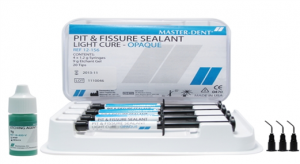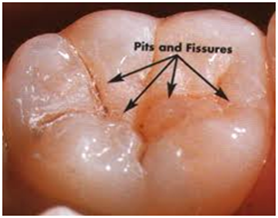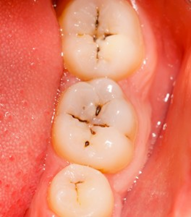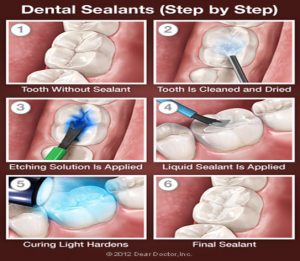Kids are notoriously bad brushers and tend to ignore the problem areas in back of the mouth that leads to decay. The American Dental Association recommends that kids receive dental sealant as soon as their adult teeth erupt as a preventative measure. This would be around age of 6 for most children.
What are Dental Sealants?
Sealants are type of plastic material that is placed in the pits and fissures of the chewing surfaces of child teeth, particularly the molars at the back because toothbrush can’t reach all the way into the grooves to clean well. Dental sealants have been proven to be a safe and cost-efficient dental procedure for child prone to cavities. It acts as a barrier to “seal-off” space between the tooth surface and any small food particles or bacteria.
 Benefits of dental sealants:
Benefits of dental sealants:
1) Paired with good oral health care, sealants are 100% effective against cavities in teeth that are sealed and properly maintained.
2) Minimally invasive and safe.
3) Cost effective
Why sealants?
Thorough brushing and flossing we can removes food particles and plaque from the smooth surface of teeth, but toothbrush can’t reach all the way into depression and groves. While fluoride helps to prevent decay, dental sealant add extra protection for the grooves and pitted areas.

 Who should get sealants?
Who should get sealants?
Children should get sealants on their permanent molars as soon as the teeth come in-before decay attacks the teeth.
- The first permanent molars-come in between the age of 5 to 7.
- The second permanent molars-come in between age of 11 to 15.
- Other teeth with deep pits and grooves might need to be a Sealant.
- Teenagers and young adults who are prone to decay may also need sealant.
What to expect during a sealant procedure
Placing dental sealants is usually painless and doesn’t require drilling or numbing medications.
Step-1: TOOTH PREPARATION
First the dentist will polish the surface of the tooth to remove plaque and food debris. Next he/she will etch the surface of the tooth, and rinse of the etching material and dry the tooth
STEP- 2: SEALANT APPLICATION
The Dentist will apply the dental sealant material to the surface of the tooth with a brush; a self-curing light will be used for about 30 seconds to bond the sealant to the tooth surface.
 STEP-3: EVALUATION
STEP-3: EVALUATION
Finally, the Dentist will evaluate the dental sealant and check its occlusion. Once the dental sealant has hardened it becomes a hard plastic coating, and you can chew on the tooth again. After getting the sealant treatment, it’s still necessary to visit your dentist at every 6 month for periodic check-up and oral prophylaxis.
 So visit US Dental now to prevent your kids against dental cavities.
As we all know – “Prevention is always better than cure”
So visit US Dental now to prevent your kids against dental cavities.
As we all know – “Prevention is always better than cure”

 Benefits of dental sealants:
1) Paired with good oral health care, sealants are 100% effective against cavities in teeth that are sealed and properly maintained.
2) Minimally invasive and safe.
3) Cost effective
Why sealants?
Thorough brushing and flossing we can removes food particles and plaque from the smooth surface of teeth, but toothbrush can’t reach all the way into depression and groves. While fluoride helps to prevent decay, dental sealant add extra protection for the grooves and pitted areas.
Benefits of dental sealants:
1) Paired with good oral health care, sealants are 100% effective against cavities in teeth that are sealed and properly maintained.
2) Minimally invasive and safe.
3) Cost effective
Why sealants?
Thorough brushing and flossing we can removes food particles and plaque from the smooth surface of teeth, but toothbrush can’t reach all the way into depression and groves. While fluoride helps to prevent decay, dental sealant add extra protection for the grooves and pitted areas.

 Who should get sealants?
Children should get sealants on their permanent molars as soon as the teeth come in-before decay attacks the teeth.
Who should get sealants?
Children should get sealants on their permanent molars as soon as the teeth come in-before decay attacks the teeth.
 STEP-3: EVALUATION
Finally, the Dentist will evaluate the dental sealant and check its occlusion. Once the dental sealant has hardened it becomes a hard plastic coating, and you can chew on the tooth again. After getting the sealant treatment, it’s still necessary to visit your dentist at every 6 month for periodic check-up and oral prophylaxis.
STEP-3: EVALUATION
Finally, the Dentist will evaluate the dental sealant and check its occlusion. Once the dental sealant has hardened it becomes a hard plastic coating, and you can chew on the tooth again. After getting the sealant treatment, it’s still necessary to visit your dentist at every 6 month for periodic check-up and oral prophylaxis.
 So visit US Dental now to prevent your kids against dental cavities.
As we all know – “Prevention is always better than cure”
So visit US Dental now to prevent your kids against dental cavities.
As we all know – “Prevention is always better than cure”

